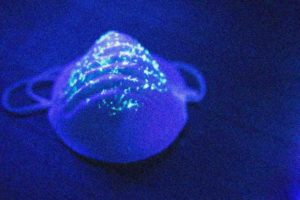Germicidal Ultraviolet (GUV) Light for Viral Inactivation

Types of UV and visible light
- Visible light at 405nm. Inactivates e-coli, C-diff, etc. (bacterial), but minimally effective against viruses and has no risk to human health
- UVA – 315 to 400 nm -Used in tanning beds
- UVB – 280 to 315 nm -Used to treat plaque psoriasis and other skin conditions
- UVC – 100 to 280 nm -Used for viral and bacterial inactivation
- 254 nm is common for inactivation, but when used directly can be skin and eye hazard
- 222 nm commonly referred to as far UVC. Effective in inactivating viruses and bacteria; safe for human exposure within limits
The far UVC shows promise in being able to disinfect spaces while being safe for human occupation. The American Conference of Governmental Industrial Hygienists (ACGIH) has set a standard of 3 mJ/cm2/hour. At this level, 95% viral inactivation would occur in in 8 minutes, 99% in 16 minutes, and 99.9% in 25 minutes. A Columbia University[1] study also supports the safety and germicidal efficacy of narrow band UV at 222 nm.
UVC is often used in air ducts. Unfortunately, this method is not very effective in preventing person to person transmission where an infectious person is in the same room as a healthy person. For effective interruption, air disinfection must occur in the same room as transmission.
[1] Germicidal Efficacy and Mammalian Skin Safety of 222-nm UV Light; Buonanno et al
UV portals are not effective inactivating viruses. Hand held wands may be effective if held over the small object or desk for several seconds.
Either of the UVC spectra can be installed safely if guidelines are followed.
- If 254 nm is installed near the ceiling, in a cove to prevent direct exposure, it would inactivate airborne viruses. This may be effective since hot air rises and a person’s breath is hot moist air or a low velocity fan is installed in the room
- Lights with UVC chambers built in. A fan pulls room air through chamber and virus is inactivated and discharged
- If 222 nm lighting is installed, exposure measurements must be made around the room to ensure safety.
[1] Germicidal Efficacy and Mammalian Skin Safety of 222-nm UV Light; Buonanno et al
Why Call EPL for Your Lighting Upgrade?
EPL keeps up to date with the latest research on light and health. We know what light keeps staff more alert to lower medical errors, improve visual diagnosis, and provide a more inviting, cheerful environment while dramatically lowering your energy costs. EPL has the expertise on light and human health, call or send an email to learn how lighting can improve your outcomes.
On-Site Lighting Assessment
Request a lighting assessment and an EPL lighting professional will reach out to learn more about your lighting needs and answer your questions.
Our thorough, on-site lighting assessments include:
- Complete facility lighting evaluation with room-by-room counts of existing lighting fixtures, light level readings and other detailed measurements
- A lighting upgrade proposal based on the lighting needs for the work performed
- An Energy Savings Report
- Available Financial Incentives/Rebates
- Public and Private Financing Available
Interested in an LED Upgrade? Curious about Budget Numbers/Available Options?
Contact Sales at:
(608) 661-5555
Or, send us a message using this form:
